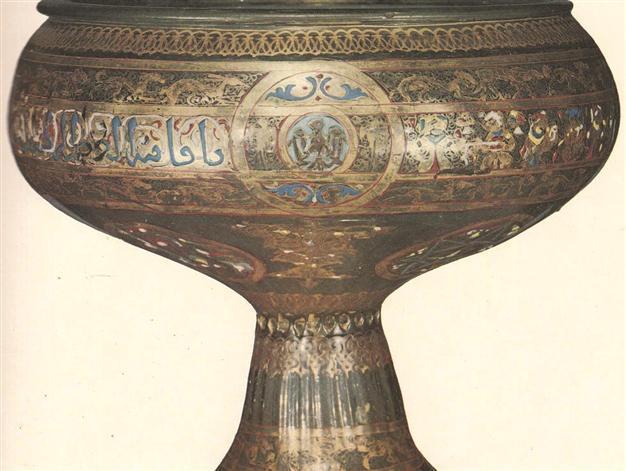Windows for the Ottoman world
Niki GAMM Hürriyet Daily News

Glass from Syria with enamel decoration, Metropolitan Museum of Art.
“Who, when he first saw the sand and ashes by casual intenseness of heat melted into a metalling form, rugged with excrescences and clouded with impurities, would have imagined that in this shapeless lump lay concealed so many conveniences of life as would in time constitute a great part of the happiness of the world?” wrote English writer, lexicographer and essayist Samuel Johnson (1709 – 1784).Johnson was of course describing glass, speculating on how it might have been discovered in some long-ago era. The latest thought is that glass was discovered by accident in Syria. In its simplest form it requires alkali and silica, two substances found in abundance on a sandy beach under Mt. Carmel in present-day northern Israel. The ancient Roman historian Pliny wrote how merchants accidentally discovered glass when they were cooking on the shore because they had placed their hot cooking pots on rocks of nitrate that then produced an opaque liquid. The suggested date is around 5000 B.C. That the Phoenicians exported glass, initially probably as beads, in the eastern Mediterranean is well known.
While the Egyptians also had glass, archaeological evidence has dated the glass found in Egypt to approximately 3500 B.C. For once, the people of the Middle East found and developed an item substantially before the Chinese did in the 16th century B.C. The oldest examples of glass vases come from Mesopotamia a century later. Blown glass didn’t appear until the end of the first century B.C. and the beginning of the first century A.D., again among the Syrians. The Romans were responsible for spreading the use of glass through trade and conquest. They also discovered the way to make clear glass and flat glass for windows.
Glass was commonly in use among the Byzantines for beads, jewelry, jars and windows. In addition the Byzantines used glass for their marvelous mosaic designs that decorated buildings.
At the same time, glassware and glass windows were common elements of everyday life throughout the Islamic period in the Middle East. An advancement in the use of glass was the discovery by Ibn al-Haytham (died ca. 1041) of the magnifying power of spherical segments made of glass, a precursor to the modern eyeglass. The Ottomans would have inherited their interest in glass from the Seljuks of Rum, that is, the branch of the Great Seljuks which ruled Anatolia from 1077 to 1307. For instance, the Seljuks used glass in the windows of their mosques, madrasahs and palaces. Shards of colored glass were found during excavations of the palace of Seljuk Sultan Alaeddin Keykubad I (1219-1237) near Konya. The Ottomans would at the same time have been exposed to Byzantine glassware, although it would have already reached the peak of interest in the 10th century.
Although there are many examples of Ottoman glass in museums and private collections and documents, not very much research has been carried out. Fuat Bayramoğlu, in his book “Turk Cam Sanatı ve Beykoz İşleri,” points out the guild system under the Ottomans secured rights for the men who belonged to the individual guilds. The work expected of the masters, apprentices and others was spelled out. Salaries were spelled out and help was extended to any member of the guild who became disabled or retired. Foundations were set up to ensure needs were met. The names of the glassware, weight and price were also determined.
Following the conquest of Istanbul in 1453, the center of glassmaking was in the capital. A good source of white sand needed to produce fine quality glass was a half-day’s journey outside Yedikule. The places where glass was produced were in the vicinity of Eğrikapı and Tekfur Palace. At Topkapı Palace there were up to 45 craftsmen involved in producing items to meet the needs of the palace and among those were glassmakers. The 17th-century traveler Evliya Çelebi writes that in his time there were 364 stores and businesses involved in glass and some 1,000 people. In the third quarter of the 18th century, Sultan Mustafa III (r. 1757-1774) ordered that all glass workshops be centered at Tekfur Palace.
Among the Ottomans there were three basic types of glass produced: flat glass, colored glass and crystal. Bayramoğlu further divides the glass into luxury products, useful products such as were used by the army and in everyday life and ornamental glass. Under luxury glass, one finds lamps, candleholders, tulip vases, cups, sugar bowls, glasses, mirrors, and pharmaceutical bottles among other items. Useful products included bombshells, boat lanterns, lighthouse lights, and the bottles for the tops of hamam domes. Ornamental glass was colored and basically used in windows.
We are fortunate to have illustrations related to glassmakers in the Surname-i Hümayun, a book produced for the 1582 celebrations on the occasion of the circumcision of Prince Mehmed (later Sultan Mehmed III), the son of Sultan Murad III. One of the miniatures shows the glassmakers actually working, complete with an oven in which they are shown heating the glass.
Beykoz glass
In the 19th century Beykoz glass became highly popular. The glassworks at Beykoz were started by a Mevlevi dervish named Mehmed Dede during the reign of Sultan Selim III (r. 1789–1807). Mehmed Dede is supposed to have gone to Italy where he learned the craft and brought the knowledge back with him. Of all the glass, the Çeşm-i bülbül or eye of the nightingale, is the most famous. The various glassworks at Beykoz finally shut down at the end of the 19th century because they couldn’t compete with glassware being imported from Europe. Turkey’s leading glassware maker today, Paşabahçe, didn’t open until 1935 and it produces some of the outstanding types of glass that the Beykoz factories once did.
For people interested in glassware from the past, the Medusa Archaeological Museum of Glass Works in Gaziantep has recently been in the news (Hürriyet Daily News, Dec. 7-8, 2013). Housed in two historic Antep houses, it has the second largest collection of glassware in Turkey after the collection at the Sadberk Hanım Museum in Istanbul.
















